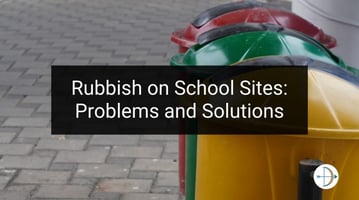I realise as I type this that the subject of rubbish on school sites is about as mundane as it...
Broken Windows Behaviour
The Broken Windows study, carried out by social scientists James Wilson and George Kelling in 1982, highlights the link between conspicuous maintenance of an urban environment and the apparent reduction of crime and disorderly behaviour. The basic thinking is this: a broken window that is left unrepaired signals that nobody’s particularly bothered about the building, and so it’s likely that more windows will be broken. Wilson and Kelling argue that ‘vandalism can occur anywhere once communal barriers – the sense of mutual regard and the obligations of civility – are lowered by actions that seem to signal that no one cares.’
"One unrepaired broken window is a signal that no one cares, and so breaking more windows costs nothing."
Preventing the relatively small stuff like vandalism – window breaking, for example – helps to create an atmosphere of lawfulness which, in turn, helps to prevent more serious crime from flourishing in the community. It’s about cracking the small stuff to prevent the big stuff from happening. You can read the full paper here.
Where schools are concerned, I think it’s easy to overlook the small stuff – the stuff that’s akin to those single broken windows, for example:
- Infringements of school uniform rules
- Rubbish left on the floor after break and lunch
- Vandalised toilets
- Missed detentions
- Lateness to lessons
- Swearing
- Noisy and disorderly transition between lessons
Obviously, a kid in trainers isn’t going to stop the school day from rumbling on. Rubbish left on the canteen floor won’t prevent the next lesson from taking place. And if a ten minute lunchtime detention’s missed, so what? When there are much more serious incidents to focus on, and where there are other pressures to contend with in the school day, why not turn a blind eye and walk on? The trouble is, combined, all the small stuff adds up and, before long, the signal is sent that no one cares. And that’s when poor behaviour at a low-level becomes normalised and tolerated, enabling more serious incidents to take place with greater frequency.
I don’t believe that anyone working at a school turns a blind eye because they don’t care, but it still happens – so why is this? Usually, at least in my experience, it’s because staff don’t feel empowered to take action (because they’ll be ignored or abused by the students they challenge) or because taking action involves a lengthy process that requires a disproportionate amount of time to engage with properly. Sometimes, where there’s a particularly toxic culture, staff will fail to challenge students or report incidents because they fear that they’ll be perceived as a weak or incompetent for raising an issue in the first place.
Where this is the case, it’s the responsibility of senior leaders to make changes. Clearly, doing this meaningfully is not an entirely straightforward undertaking. However, as a starting point, a simple, transparent system of sanctions matched to common broken window offences – that all staff feel able to apply consistently – should be put in place. Whilst this alone won’t make a huge difference to the behaviour of the most challenging students, it will help to slowly change the culture of the school and, overall, behaviour will improve (as an aside: I’m not convinced that the severity of the sanctions themselves particularly matter: I suppose it’s about the certainty that they’ll be applied by all members of staff, in all cases).
I know that other factors are at play, too. There is, sadly, no panacea for poor behaviour. Securing parental support is, for example, hugely important. And so is a decent rewards system. However, I suppose my point is this: what’s permitted is promoted. So, as a first step, at schools where behaviour isn’t good (and, actually even at schools where it is), it’s just as important to fix the broken windows as it is to focus on the bigger stuff.
Thanks for reading –
Doug


.jpg?width=50&name=douglas-wise%20(2).jpg)


